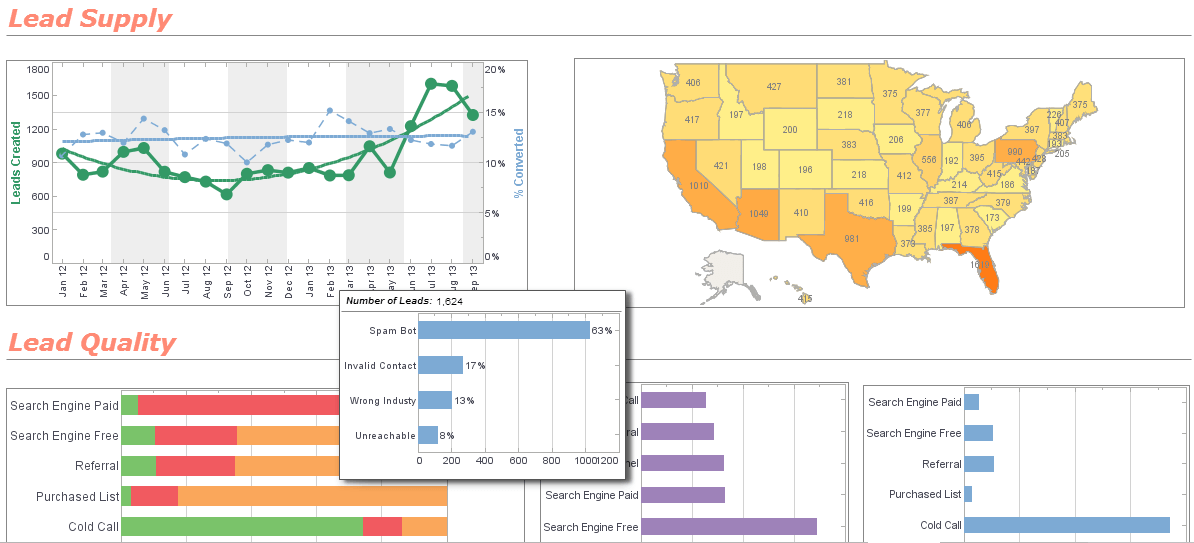InetSoft Technology: Robust Reporting Incorporated into Enterprise Business Intelligence Suites
Robust reporting has been incorporated into enterprise business intelligence suites. "Lightweight" BI and reporting vendors and products have emerged to help customers reduce tools costs and hardware requirements.
There are two significant trends in reporting technology and markets: convergence and emergence. Production reporting has converged with enterprise business intelligence suites to form a next-generation business intelligence software application. Concurrently, new "lightweight" BI and reporting software has been emerging.
 |
Read how InetSoft saves money and resources with deployment flexibility. |
Reporting and Enterprise Business Intelligence Suite Convergence
Years ago, robust enterprise (production and operational) reporting and enterprise business intelligence suites were technologically distinct. Robust reporting supported the need for complex, high-volume, precisely formatted operational reports run offline in scheduled batch mode for distribution to large audiences — push model.
The reporting offered in the enterprise business intelligence suite was focused on simple online reporting, graphical presentations, ad hoc reporting and user interaction with the data and featured a metadata layer to simplify end-user querying and reporting — pull model.
Driven by pressure on IT budgets and a desire to reduce complexity and improve integration of BI tools (as enterprise business intelligence suites do), many organizations tried to consolidate and standardize on the BI tools being used. Such actions reduce not only licensing costs, but also training and support.
Concurrently, organizations went back to basics: deploying fundamental reporting (production-type reporting and end-user reporting design and execution) enterprise wide, via the Web, often in preference to deploying more sophisticated analysis capabilities. These twin forces of consolidating products in use and combining higher-level reporting functionality with enterprise business intelligence suite functionality pressured vendors into melding this technology into a single, next-generation enterprise business intelligence suite. Some vendors have developed and introduced new products, while others have acquired the technology.
Lightweight Reporting Emergence
Just as reporting as a stand-alone product was being integrated into enterprise business intelligence suites, a new type of reporting product surfaced. These products are Java- or .NET-based and support application developers who need to embed reporting into their Java or .NET applications. Although some legacy reporting products also support .NET, some customers want lower-cost and smaller footprint (application size) products. Third-party developers that need to embed reporting capabilities into their software products feel this need most keenly.
Application size can be a big issue for such users, causing them to reject products from the "big" enterprise business intelligence suite vendors and to seek lightweight BI and reporting vendors. Customers of at least one lightweight reporting vendor include application service providers who integrate reporting as a service, in addition to IT departments and third-party developers.
Developers' use of Java and .NET technologies has created a market for reporting products that support these technologies. Java has spawned the greater number of reporting products, probably based on the greater longevity and popularity of Java. The lightweight reporting products are based on Java and .NET Web services application development technology. They leverage application servers and add functions as necessary. Consequently, these products are lightweight, not in terms of performance design, but rather in application footprint. Being server-based, they leverage performance and scalability features such as multithreading, caching and load-balancing.
"Big" enterprise business intelligence suites and robust enterprise reporting products became bloated because, over time, vendors have added functionality to satisfy customer requests. Ironically, this created opportunity for the current crop of lightweight BI and reporting vendors.
At the same time, customers' demands have influenced vendors to add analysis capabilities such as drilling and cross-tab operations, as well as support for more-robust reporting and dashboards, and deeper online analytical processing (OLAP) support.
Some lightweight BI and reporting products include templates that enable developers to give report and dashboard consumers the ability to modify or create reports and dashboards. By providing additional functionality and planning to add easy-touse report and dashboard designers for end users, these products will encroach on enterprise business intelligence suites and, ultimately, may become enterprise business intelligence suites.
The lightweight BI and reporting market, as typical of an emerging market, is composed of entrepreneurial vendors that offer Java BI and reporting products based on the Java 2 Platform, Enterprise Edition (J2EE) computing platform— for example, products from InetSoft Technology.
Recommendation
Consider the lightweight BI and reporting vendors if you:
- Want to embed reporting or dashboards in J2EE or .NET applications
- Need to minimize the size of the applications
- Have dashboard and report users who are needing extensive report-design and self-service capabilities
- Need more-comprehensive BI functionality, such as that provided by an enterprise business intelligence suite, but with more flexible licensing options
Bottom Line: Robust production reporting and dashboard technology has been incorporated into enterprise business intelligence systems so that customers usually can select a single product for robust reporting and for end users' ad hoc reporting and analysis needs. New, small vendors of Java reporting technology are offering less-expensive and easier-to-use products. You may find their products appealing, particularly if you want to embed reporting into applications.
 |
Read why choosing InetSoft's cloud-flexible BI provides advantages over other BI options. |



